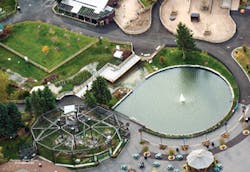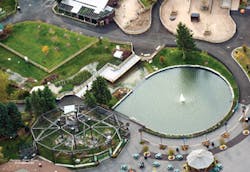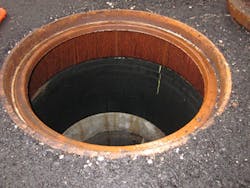By Ben Seldomridge
Two cities are facing two daunting tasks: The city of Lancaster, Pa., must make progress to capture 750 million gallons of stormwater per year by 2025, while the city of Syracuse, N.Y., must capture 250 million gallons of stormwater per year by 2018.
New stormwater regulations imposed by the Environmental Protection Agency (EPA) are requiring Lancaster to make significant efforts to curb and mitigate this form of water pollution; in response, it created the "Save It!" program. Meanwhile, Syracuse must curb its stormwater due to a legal case in 1989, which ultimately led to the development of the city's current "Save the Rain" program.
The City of Lancaster
Lancaster, under the direction of its Public Works Director Charlotte Katzenmoyer, created the Save It! program to encourage the community, through economic incentives, to mitigate stormwater runoff on its land. The program began when President Obama declared the Chesapeake Bay a "national treasure" in an address to the country in 2009. Since then, the EPA has placed stricter regulations on all municipalities to mitigate stormwater runoff.
Typically, Lancaster can handle the treatment of 7 billion gallons of water per year through its wastewater treatment plant. However, these facilities can become overwhelmed when stormwater flowing through the combined storm sewer (CSS) overloads their capacity, creating a combined sewer overflow (CSO). In Lancaster's case, this dumps raw sewage into the Conestoga River, which ultimately leads to the Chesapeake Bay. The EPA will levy $37,500 in fines to municipalities each time this happens unless significant progress is made.
The Save It! program tackled this problem by implementing a green infrastructure plan. "There are two alternatives: green infrastructure and gray infrastructure," said Lancaster Mayor J. Richard Gray. "Gray infrastructure would say you hold polluted stormwater in large holding tanks, and then when you have the capacity, you clean it up and put it in the river." This method is expensive and inefficient when compared to green infrastructure. "[With] the green infrastructure program, one of its primary goals is to take stormwater and infiltrate it back into the soil," he said.
At a cost-per-gallon ratio, gray infrastructure would cost the city 30 cents per gallon, while green infrastructure would cost 16 cents per gallon on average. Green infrastructure is a more desirable alternative for Lancaster.
Lancaster uses a combination of grants, sewer fees and a new stormwater fee to pay for this program. Homeowners and businesses are now required to pay a fee based on the total impervious area on their lot. However, this cost can be reduced if the homeowner implements "green" measures such as installing a rain barrel, adding porous pavement or installing a green roof.
LIVE Green is another program designed to bolster green infrastructure. This urban greening program is working to foster support between non-profit, for-profit and governmental entities to invest and incorporate green infrastructure into urban environments. Thus far, LIVE Green's main achievement was supporting the installation of 12 green roofs throughout Lancaster.
Lancaster's tree-planting program, TreeVitalize, brings even more organizations together, attracting the financial support of the Department of Conservation and Natural Resources and the Lancaster County Conservation District. According to the LIVE Green website, over 250 trees have been planted throughout the city with the overall goal of increasing canopy cover from 28 to 40 percent over 40 years.
The City of Syracuse
About 300 miles north of Lancaster, the city of Syracuse is implementing its Save the Rain program. This idea began in 2009 with a stormwater management plan to further the cleanup of Onondaga Lake. The Onondaga Lake Amended Consent Judgment (ACJ) was first filed in 1989 due to a series of violations that led to unlawful discharges of pollutants in the lake. Initially, the plan began by upgrading the city's sewage treatment plants so they could handle the discharges from the CSS during heavy rain events.
Progress on this plan was halted due to the worsening smell in a city sector already laden with low-income households. The plan was signed in 1998 and retrofitted to its final form in 2009 when the city began the fourth stipulation of the ACJ. The program incorporates green infrastructure in conjunction with the gray infrastructure of the existing treatment plants -- all with the goal of integrating pollution mitigation, increasing aesthetic appeal and restoring the natural hydrologic cycle.
Like Lancaster's initiative, this program has a strong focus on community support through individual projects. However, the biggest difference lies in the resource that is affected. Onondaga Lake has endured a series of past pollution problems such as mercury dumping, soda ash waste beds on its shores, salt mine drainage, and now increasing stormwater runoff. With all of these allegations stacking up in Syracuse, how is it that one city can pay for the cleanup?
Through the Save the Rain program, the Green Investment Fund (GIF) and the Suburban Green Infrastructure Program (SGIP) enable landowners to facilitate green projects. An incentive-based program, GIF provides funding for landowners within Syracuse to implement rain gardens, bioswales, green roofs, rain barrels, or porous pavement. The SGIP provides funding to public properties both within and outside of Syracuse that can be used for storm sewer repair and separation, in addition to green infrastructure.
One notable project is at Syracuse's Rosamund Gifford Zoo. The project aimed not only to enhance habitats for zoo wildlife but also reduce the zoo's water use. A constructed wetland was integrated within the waterfowl exhibits to collect rainwater, enabling it to reincorporate with the natural hydrologic cycle. According to Save the Rain, this marks the first wetland in the country repurposed for an urban environment.
Another example is the Clinton Storage Facility. Rather than building another sewage treatment plant, Onondaga County constructed this 6.5-million-gallon CSO storage utility in downtown Syracuse. During wet weather events, its three underground tunnels collect stormwater until it can be treated by the main wastewater treatment plant.
In addition to facilitating projects, Save the Rain also encourages community involvement with green programs such as rain barrel installation, vacant lot purchases and tree planting. For example, one project integrated a rain garden and an urban forest on site. The design specifications state that over 93,000 gallons of water per year are captured. As an added benefit, projects like these will attract wildlife to the city, ultimately providing more ecosystem services for the area.
Conclusion
Plants that can be harvested, such as serviceberries, can also provide stormwater benefits by reducing overland flow and incorporating natural hydrology to an urban environment. Wetlands, like those at the Rosamund Gifford Zoo, enable ducks and fish to breed, which not only sustains existing wildlife but also attracts former species back to their respective environments.
The cities of Lancaster, Pa., and Syracuse, N.Y., are two geographically separate areas working similarly to improve stormwater management and limit pollution into the Chesapeake Bay and Onondaga Lake. This, in turn, benefits the aesthetic appeal of both cities while reincorporating the natural hydrologic cycle at the same time.
About the Author: Ben Seldomridge is a recent graduate of State University of New York-College of Environmental Science and Forestry with a degree in Natural Resources Management. He has worked in fields such as stormwater management, wastewater management and land conservation.
waterconnections
Manhole Reconstruction Project Makes the GradeA series of manholes along a busy concrete roadway with heavy truck traffic in Waukesha, a suburb of Milwaukee, Wis., had been deteriorating over time. When constructed, the manhole frames and covers had been adjusted to final grade with concrete grade rings.
These masonry materials were typical at the time, but heavy traffic and harsh Wisconsin winters had taken a toll. By 2012, almost all the frames and covers in the southbound lane, which were also in the wheel line of traffic, had sunk slightly.
Not only were the manholes taking a beating, so were the vehicles traveling on the roadway. To protect both, Waukesha specified PRO-RING™ by Cretex Specialty Products on a project to reconstruct the grade adjustment area on 25 manholes.
PRO-RING is manufactured from expanded polypropylene, a lightweight, high-strength plastic that has an energy dissipating property. It weighs 95-percent less than typical concrete grade rings, yet meets or exceeds AASHTO HS-25 loading and has excellent chemical resistance.
It was clear to the city that the most common failure mode in its manholes was due to the freeze-thaw cycle, but there had been little to no success when it came to repairing this portion of the manhole. The PRO-RING worked so well on this project that Waukesha performed a cost-benefit analysis to investigate expanding its use.
Installation of the PRO-RING was about 1.1 times more expensive, but in terms of maintenance, the city expects to come out ahead due to the 50-year design life. As a result, Waukesha started using the system on all sanitary manholes in 2013 and has since begun using it on all storm manholes.
Since installing PRO-RING, the city has eliminated the use of any concrete grade rings to adjust its manholes.
More WaterWorld Current Issue Articles
More WaterWorld Archives Issue Articles





